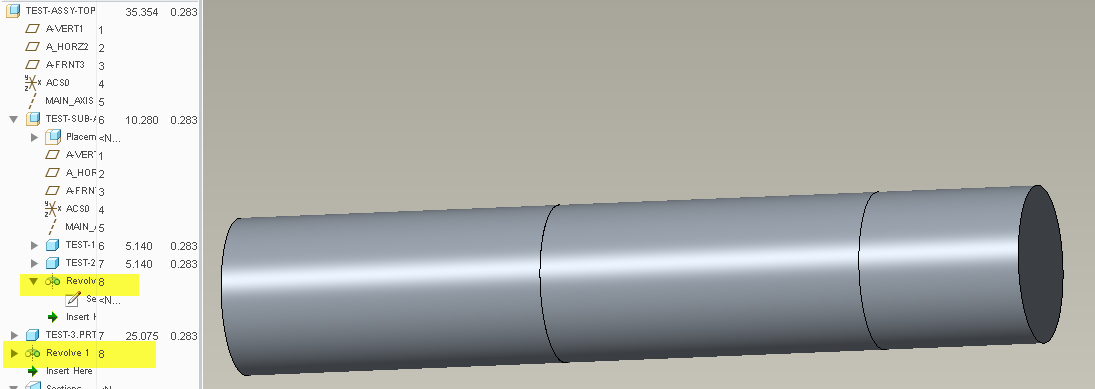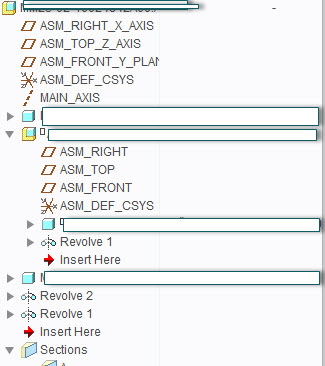Community Tip - Learn all about the Community Ranking System, a fun gamification element of the PTC Community. X
- Community
- Creo+ and Creo Parametric
- 3D Part & Assembly Design
- Creo 2.0: Cut-revolve in assembly adds material (c...
- Subscribe to RSS Feed
- Mark Topic as New
- Mark Topic as Read
- Float this Topic for Current User
- Bookmark
- Subscribe
- Mute
- Printer Friendly Page
Creo 2.0: Cut-revolve in assembly adds material (cancels out revolve-cut of lower level sub-assy)
- Mark as New
- Bookmark
- Subscribe
- Mute
- Subscribe to RSS Feed
- Permalink
- Notify Moderator
Creo 2.0: Cut-revolve in assembly adds material (cancels out revolve-cut of lower level sub-assy)
Hello
I have a sub-assy that is welded and machined.
It consist of a part and a sub-assy, this sub-assy contains one purchase part wich is machined with a cut revolve.
If I now apply a cut-revolve on the highest level sub-assy, it cancels out the cut-revolve on the lower sub-assy. Making the purchase part the original size.
If I want to fix this again, I have to supress all parts and resume the original sub-assy with purchase part and machining.
This is a contradiction on the idea that features are build on a logical order and are not later on recalled.
My colleague sais it has to do with removing something from wich already has been removed and he sais a workarounds works just fine.
For me, this is not acceptable, for cutting material on sub-assy level gives the strongest representation of workflow and has the strongest parametric basis (rather then applying machining on part level).
This thread is inactive and closed by the PTC Community Management Team. If you would like to provide a reply and re-open this thread, please notify the moderator and reference the thread. You may also use "Start a topic" button to ask a new question. Please be sure to include what version of the PTC product you are using so another community member knowledgeable about your version may be able to assist.
- Labels:
-
Assembly Design
- Mark as New
- Bookmark
- Subscribe
- Mute
- Subscribe to RSS Feed
- Permalink
- Notify Moderator
This may be an accuracy issue. If Creo is having trouble resolving the geometry then it may be suppressing the cut at the lower level which would in effect add material back in.
Try increasing the accuracy.
Alternatively you could use flexibility to turn on that feature at the assembly level. You could also create a part rep that turns that feature off at the part level but still maintain it at the assembly level.
- Mark as New
- Bookmark
- Subscribe
- Mute
- Subscribe to RSS Feed
- Permalink
- Notify Moderator
This is not normal. Just to be sure, even though I have done it before, I made test parts and a test assembly and everything works well.
Can you share the model? Can you provide more specific information? Are there model failures or regeneration errors.?
I suspect there is something about your model(s) that is causing a problem.
Below is an image of my test model, with 2 levels of revolved assembly cuts.

- Mark as New
- Bookmark
- Subscribe
- Mute
- Subscribe to RSS Feed
- Permalink
- Notify Moderator
Hello Stephen and Christopher.
Thank you for your reply and your time.
I have enclosed a video showing the problem, together with a snagit of the structure tree.
Please ignore the calculator as it is placed for the obvious reason of IP.



